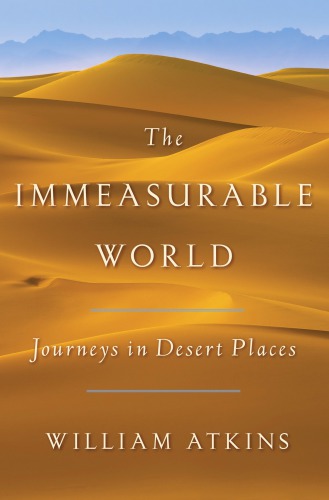
The Immeasurable World
Journeys in Desert Places
کتاب های مرتبط
- اطلاعات
- نقد و بررسی
- دیدگاه کاربران
نقد و بررسی

May 14, 2018
British author Atkins takes readers on a thoroughly enjoyable tour of the world’s deserts. After a breakup with his girlfriend of four years and a week spent with Cistercian monks in southwest England, Atkins (The Moor) became obsessed with deserts. His fascination began when he read, in the monastery’s well-stocked library, accounts of desert explorers and he soon became consumed with the desire to “stand in the desert... and imagine what it might to do to a person who abandoned himself to it.” And so began an odyssey that took Atkins to eight deserts across the globe: the Empty Quarter in Oman, the Gobi and Taklamakan in China, Australia’s Great Victoria, the Aral Sea area in Kazakhstan, the Black Rock and Sonoran in the U.S., and Egypt’s Eastern Desert. Interspersed with his own adventures are tales of those who have gone before him, such as Christian missionary Mildred Cable, who traveled the Gobi desert at the turn of the 20th century. Atkins also takes a contemporary look at deserts, describing, for example, the setting of the Burning Man festival in Nevada’s Black Rock Desert. Atkins infuses his travel writing with poetic prose (he describes the Great Australian Bight as “a callused web of skin between two digits”) to describe the beauty of what many consider to be wastelands. Atkins’s thoughtful book is a wonderfully satisfying travelogues.

June 1, 2018
In the mid-2010s, Atkins (The Moor) decided to travel to the least hospitable parts of the globe, what early polar explorers called "the zone of maximum inaccessibility." The outcome is a fascinating look at seven deserts--in Oman, Australia, China, Kazakhstan, the United States, and Egypt--in a study that tells us as much about humans as the desert. Oman's Empty Quarter only gets two-fifths of an inch of rainfall yearly. Once a year at the Burning Man Festival in Black Rock, AZ, you can take part in a dildo toss. The Kazakhstani still hope to revive their fishing industry, destroyed when the Aral Sea, once the fourth-largest inland sea in the world, shrank from 26,000 to 2.6 square miles in 30 years. In the Great Victoria Desert, aboriginal people wander through nuclear "hot" zones. The desert is neither quiet nor still. Ever-restless winds redistribute the sand daily. In the Sonoran Desert, cicadas sing. Everywhere there are ravens or vultures, the constant susurrus of wind. VERDICT The subject is riveting, the gorgeous prose reminiscent of nature observers from Thoreau to Leopold. Lovers of good descriptive writing will eat up this book.--David Keymer, Cleveland
Copyright 2018 Library Journal, LLC Used with permission.

June 1, 2018
A wide-ranging travelogue, covering eight deserts, interspersed with historical accounts of desert geography and travel.Making up one-sixth of our planet's land, deserts have fascinated writers since the dawn of Christianity, a group that includes Atkins (The Moor: A Journey into the English Wilderness, 2014), the former editorial director of Pan Macmillan UK. A lucid observer, the author chronicles his travels through the world's most arid lands, ruminating on their history, natural history, ongoing conditions, and mostly discouraging future. Viewing the world through British eyes, he makes a beeline for the first of his eight deserts, the great Empty Quarter of Saudi Arabia and Oman, a destination of the author's most flamboyant countrymen, from T.E. Lawrence to Harry St. John Philby, whose paths he has tried to follow. Next up is Australia's Great Victorian Desert, still partly off-limits as a result of 1950s British nuclear tests and home to a large Indigenous population ejected from their lands to accommodate the tests. No one was ejected from the Kyzylkum Desert in central Asia, but the population was impoverished as Soviet irrigation emptied the Aral Sea. American readers will enjoy the absence of depressing news from Nevada's Black Rock Desert, and they will also find an account of the nostalgic wackiness of the Burning Man festival. In the Great Sonoran Desert to the southwest, thousands of migrants have died trying to reach the United States. Atkins describes activists who set out water and provisions deep in the desert and the vigilantes and Border Patrol agents who destroy them. Each section begins with a detailed map to help situate readers in the region. The book doesn't contain an underlying theme, and Atkins learns most of his history and science from books, but he has an acute eye and delivers unrelated but satisfying journalistic accounts of the world's hottest, driest regions.
COPYRIGHT(2018) Kirkus Reviews, ALL RIGHTS RESERVED.

Starred review from July 1, 2018
Former British publishing executive Atkins' richly written account of his travels across deserts around the world brings Bruce Chatwin to mind, along with others who, like Atkins, have explored and have an affinity for the solitude and vast expanse of the Earth's empty places, such as Wallace Stegner, Gretel Ehrlich, and Sara Wheeler. Like theirs, Atkins' prose is gorgeous, but he can also be cantankerous as he explores eight deserts on five continents: the Empty Quarter of Oman, the Gobi and Taklamakan Deserts of China, the Great Victoria Desert of Australia, the man-made desert of the Aral Sea in Kazakhstan, the Black Rock and Sonoran Deserts of the American Southwest, and the Eastern Desert of Egypt. He also evokes the spirit of earlier desert travelers, including St. Anthony, T. E. Lawrence, and John Wesley Powell. Atkins is mesmerized by the silence of the desert while being drawn to what he refers to as its essential lawlessness. The desert, he suggests, is a place where norms are suspended. The chapter on the Burning Man festival in Nevada captures the essence of the desert as both a permissive space and a refuge. With a fine desert bibliography, Atkins' book of journeys will be a modern-day classic.(Reprinted with permission of Booklist, copyright 2018, American Library Association.)

























دیدگاه کاربران